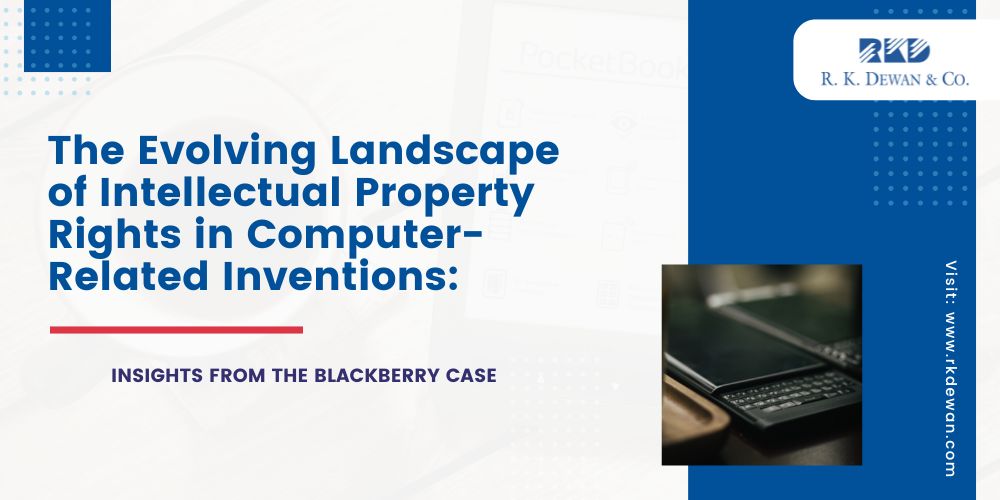Insights from the Blackberry Case
In recent years, intellectual property rights (IPR) for software and computer-related innovations have gained significant importance as digital technologies increasingly shape global innovation. Software and algorithms, which form the foundation of many technological advancements, are recognized for their substantial role in fostering creativity and supporting economic growth. Consequently, patent laws worldwide have attempted to strike a balance between safeguarding these innovations and allowing public access to technology. However, differences in global patent regimes have made navigating the patentability of software and algorithms challenging for inventors, especially as technological landscapes continue to evolve.
Globally, legal frameworks are evolving to accommodate technology and computer-related inventions, with jurisdictions like the EU, UK, and the US refining patentability standards to protect software and algorithm-based innovations. The EU, for instance, permits patents for computer programs that demonstrate a technical contribution, while the US emphasizes practical applications within its eligibility criteria.
In India, computer-related inventions (CRIs) face a more restrictive framework under Section 3(k) of the Patents Act, which excludes business methods, mathematical methods, algorithms, and computer programs “per se” from patentability. However, through carefully crafted CRI guidelines, India attempts to strike a balance by allowing software inventions that exhibit a clear technical contribution beyond mere algorithmic functions, thereby supporting innovation within defined legal limits.
The Blackberry Case: A Landmark Decision in Computer-Related Patent Law in India
The Blackberry Limited vs. Assistant Controller of Patents and Designs case has provided critical insights in understanding the limitations and nuances of Indian patent law for computer-related inventions. Blackberry filed a patent application titled “Administration of Wireless Systems” on July 25, 2008, to address the efficient configuration and management of wireless communication systems through server-client interactions. The Indian Patent Office (IPO) issued objections, citing redundancy, lack of inventivestep, and most importantly, non-patentability under Section 3(k) of the Patents Act. It is pertinent to note that the invention has received a patent in countries known for having some of the most stringent patenting systems in the world, including the USA, China, and Europe.
Blackberry argued that its invention involved technical aspects beyond just a mere algorithm, emphasizing the novelty and inventive technical contribution of the invention. However, in 2019, the Controller rejected the application, noting that it was largely software-based, with claims viewed as functional instructions devoid of inventive hardware. This rejection prompted Blackberry to appeal to the High Court of Delhi, challenging the Controller’s decision and interpretation of Section 3(k).
In this landmark case, the court provided several essential clarifications that significantly guide the understanding of Section 3(k) and its application to computer-related inventions in India.
Absolute Bar on Business Methods, Mathematical Methods, and Algorithms
In this case, the court interpreted Section 3(k) of India’s Patents Act, 1970 as establishing a strict and unqualified prohibition on patenting algorithms, mathematical methods, and business methods in India. Unlike the EU and UK, where algorithms are qualified by the presence of qualifiers like “as such” in the provisions, allowingnuanced evaluation of algorithm-based inventions for,India’s approach lacks such flexibility.The effect of “per se” on computer programs would align the laws between India and the EU regarding these programs; however, this alignment does not extend to algorithms. The court emphasized that while computer programs may be patentable in India if tied to a specific technical application,algorithms are entirely excluded from patent eligibility regardless of any practical implementation and technical effect. This reinforces India’s particularly stringent stance on patenting software-based and algorithm-driven innovations, marking a clear departure from more flexible international standards.
Patent Drafting and Claim Construction
An essential part of the judgment lay in its analysis of claim construction, particularly the language used in Blackberry’s patent specification. The court scrutinized phrases such as “configured as a set of inter-operative instructions” and “configured to control dissemination of information,” noting that such language highlighted the instructional, algorithmic nature of the invention rather than an inventive step. This terminology ultimately contributed to the court’s interpretation that the invention was primarily algorithmic, confined within conditional “if-then” logical statements, and thus ineligible under Section 3(k).
The court’s observations underscore the importance of precise claim drafting in patent applications, particularly for CRIs. Given India’s restrictive approach under Section 3(k), applicants must carefully construct claims to emphasize technical contribution beyond algorithmic instructions, as nuanced language can shape the outcome of patent eligibility. By emphasizing the specific drafting choices in Blackberry’s application, the court highlighted how claim construction directly impacts the assessment of originality and patentability.This outcome underscores the need for inventors and legal professionals to consider the nuances of drafting patent claims in India, where language and classification profoundly impact patent eligibility.
Recognition of Technical Contribution
During proceedings, the Controller of Patents ultimately retained only the non-patentability objection under Section 3(k), focusing on the invention’s algorithmic nature.Both the Controller and the court acknowledged that Blackberry’s invention presented a technical effect and a significant technical contribution, as it aimed to improve the configuration of wireless networks, resolve data conflicts, and synchronize securely across servers and devices.
However, this technical contribution was considered insufficient to qualify for patent protection under Section 3(k) due to its algorithmic nature. This interpretation suggests that technical effects alone may not satisfy the patentability criteria for inventions based on algorithms in India, reflecting the strict legal threshold that patent applicants must meet.
Rejection of the Inventive Hardware Requirement
On a thorough assessment of the refusal order the court invalidated the Controller’s insistence on an inventive hardware requirement for patenting software-related inventions, drawing on precedents such as Ferid Allani vs. Union of India and Raytheon Company vs Controller General of Patents and Designs. In these cases, the courts clarified that requiring inventive hardware as a criterion for computer-related inventions was unjustified. The court again reiterated in this case that Computer Related Inventions (CRIs) cannot be tested on the fulcrum of requirement of inventive hardware, as the same is a higher standard which lacks any basis in law.The focus should rather be on the technical contribution or effect the invention introduces. This is a significant insight, as it underscores that the absence of novelty with regard to hardware does not inherently negate the patentability of software inventions, provided they exhibit substantial technical contributions.
Clarification on Inapplicability of Certain International Case Laws
In arguing for patentability, Blackberry referred to the European precedent of Vicom Systems (EPO decision T 208/94), which differentiated between patentable technical processes and mere mathematical algorithms. However, the court in India found this precedent inapplicable due to the nature of Blackberry’s invention, which it classified as more about network management and protocol than a transformative technical process. This interpretation signals that Indian courts may apply a more restrictive lens to international precedents when interpreting patent laws domestically, particularly for algorithm-based inventions.
Patentability of Algorithmic Implementations
Significantly, the court stated that while algorithms in isolation are non-patentable, their implementations within a technical framework could be patentable if they produce tangible outcomes. This recognition suggests that applicants may seek patents for algorithm-driven processes that are embedded within technical systems, such as those facilitating control mechanisms, if these implementations extend beyond pure instruction sequences and yield specific, measurable results. However, Blackberry’s invention, though technically robust, was interpreted as an algorithm-based process primarily governing information flow, failing to meet this threshold.
Conclusion: Implications for Patent Law and Future Innovations
The prolonged journey of patent applications in India, exemplified by the Blackberry case that took 17 long years to reach a refusal decision, reflects the complexities inherent in navigating our patent system. As innovation races forward globally, it’s vital for Indian patent law to evolve and embrace these changes, ensuring that we foster creativity rather than hinder it.The current framework, while well-intentioned, risks leaving deserving technical innovations in obscurity, unable to secure the recognition and protection they merit. As the world rapidly advances in technology, it’s essential to reimagine our approach to patent law and ensure that worthy inventions do not fall through the cracks of our existing system.
The Blackberry judgment provides pivotal insights into Indian patent law, highlighting the stance on algorithmic processes under Section 3(k) and clarifying the limitations imposed on software-driven inventions. The court reaffirmed that, while technical contributions are essential, the current legal framework in India may pose a barrier to patent protection for innovations rooted solely in algorithms.
The case has set a precedent for assessing future applications involving computer-related inventions. It reinforces the strict standards governing patentability for algorithmic inventions in India, guiding both inventors and policymakers in adapting to the legal challenges posed by rapidly evolving technological advancements.


